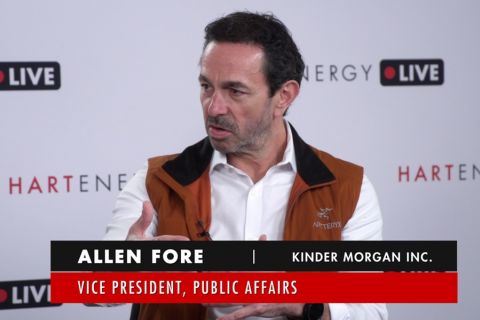
“California has set aggressive goals to achieve zero-emission fleets across vehicle categories, including cars, buses, and trucks,” said Bill Elrick, executive director at California Fuel Cell Partnership. (Source: Shutterstock.com)
Three years ago, California pledged to reach full carbon neutrality by the year 2045, a mission that would require the state to eliminate, sequester or offset any and all carbon emissions to achieve. So far, investing in the development of fuel cell electric trucks and hydrogen fueling stations has been a successful avenue to help meet its ambitious goals.
The California Fuel Cell Partnership (CaFCP) found that heavy-duty trucks account for only 2% of vehicles on California roads, yet these trucks generate more than 9% of the state’s greenhouse gas emissions, 32% of its nitrogen oxides, and 3% of its particulate emissions.
“California has set aggressive goals to achieve zero-emission fleets across vehicle categories, including cars, buses, and trucks,” Bill Elrick, executive director at CaCFP, said. “We can only achieve these goals through collaboration between government and private industry, and policies that promote and attract investment. The time to act—and invest—is now, if we intend to transition quickly and successfully to a self-sustaining market.”
The organization—comprised of auto manufacturers, energy and fuel cell technology companies, and government agencies—plans to roll out 70,000 trucks supported by 200 heavy-duty truck stations by 2035, Elrick said during the “Building Blocks for a Hydrogen Economy” webinar hosted by the Center for Strategic and International Studies (CSIS) on Nov. 16.
CaCFP has already developed over 10,000 light-duty fuel cell vehicles on the road and 50 retail fueling stations throughout existing gas stations in California, with over 100 stations in development. The alliance’s goal is to build a sustainable hydrogen economy for light- and heavy-duty applications, which in turn, will create an opportunity for hydrogen fuel cell technology advancements around the globe.
“We know we’re unique here in California but we want to make it easier for everybody throughout the U.S., North America and the world,” Elrick said.
However, converting the freight movement industry to clean energy will rely on policy solutions that drive scale, vehicle adoption and private investment.
The support of public funding will also play a role in initiating the early market by addressing market risk—reducing economic barriers to customer adoption, CaCFP said in its “Fuel Cell Electric Trucks: A Vision for Freight Movement in California and Beyond” report released in July 2021.
“To truly push zero-emission truck adoption in a customer segment that is defined by return on investment and total cost of ownership, equally strong and supportive policy levers must be put in place to drive customer demand,” the report said. “This will unlock the investment and commitment from industry and private investors to develop the necessary products and supply chain at mass market scale.”
The ideal policies would be predictable, long term, and zero-emission technology focused to create a meaningful impact.
Equally important, the buildout of hydrogen fueling infrastructure provides an opportunity to add co-located light-duty fueling. This has driven CaCFP to place an emphasis on expanding the light-duty market, which it projects will be self-sufficient by 2030.
“There is more demand for these vehicles than we have infrastructure so we need to scale up that infrastructure to match it,” he said.
By progressing the light-duty fuel cell trucks, Elrick said this will lower the costs for other applications of hydrogen infrastructure and fuel cell technology across different regions.
“The synergies associated with expanding both fuel cell electric truck and vehicle market will reduce the barrier to entry for other mobility, stationary, and industrial applications of hydrogen and fuel cells in sectors that need to reduce emissions and decarbonize,” he noted.
Elrick said there are pending regulations for light-duty transit vehicles, medium, and heavy duty trucks to be 100% zero-emissions by 2030 or 2045 (depending on the application) with specifications for fuel cell, batteries or a combination of both.
“To meet mandated deadlines, policies must address the needs of operators in conjunction with emissions reduction goals,” CaCFP said in its report. “If these market signals effectively support the adoption of fuel cell electric trucks, infrastructure buildout, and renewable hydrogen supply chain expansion, they will ultimately trigger market initiation and lead to accelerated and sustained growth.
Additionally, the transition to zero-emission trucks will need to see the widespread deployment of this new technology by trucking companies on their existing fleets. It also calls for close collaboration between truck manufacturers, truck operators, infrastructure providers, and policymakers to ensure the required fueling infrastructure is planned and built out ahead of expected demand.
Like any new vehicle technology or platform, the ramp-up to mass market scale production will take time. To help accelerate this pathway to scale, he said policies must be quickly initiated to support the integration of hydrogen fuel cell electric technology for freight movement and other states and federal agencies will need to collaborate with California to drive the global transition of trucks to zero-emission.
Recommended Reading
Laredo Oil Settles Lawsuit with A&S Minerals, Erehwon
2024-03-12 - Laredo Oil said a confidential settlement agreement resolves a title dispute with Erehwon Oil & Gas LLC and A&S Minerals Development Co. LLC regarding mineral rights in Valley County, Montana.
Watson: Implications of LNG Pause
2024-03-07 - Critical questions remain for LNG on the heels of the Biden administration's pause on LNG export permits to non-Free Trade Agreement countries.
Yellen Expects Further Sanctions on Iran, Oil Exports Possible Target
2024-04-16 - U.S. Treasury Secretary Janet Yellen intends to hit Iran with new sanctions in coming days due to its unprecedented attack on Israel.
Kinder Morgan Exec: Building Pipelines ‘Challenging, but Manageable’
2024-04-05 - Allen Fore, vice president of public affairs for Kinder Morgan, said building anything, from a new road to an ice cream shop, can be tough but dealing with stakeholders up front can move projects along.
The Jones Act: An Old Law on a Voyage to Nowhere
2024-04-12 - Keeping up with the Jones Act is a burden for the energy industry, but efforts to repeal the 104-year-old law may be dead in the water.




